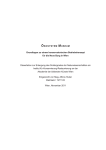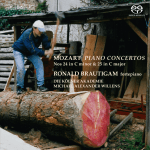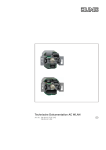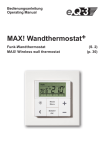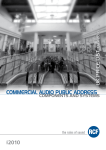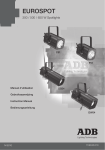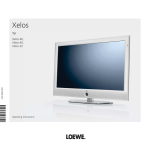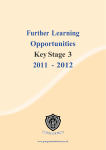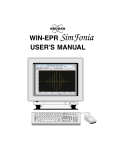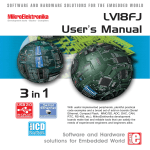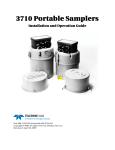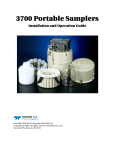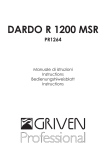Download Strand Newsletter Dec 03
Transcript
S T R A N D News December 2003 INSIDE THIS ISSUE: Our cover story The New Walt Disney Hall 2 LDI 2003 in Orlando 5 Gavin Swift writes about Lighting Santa’s Kingdom in Sydney 6 Arena Opera :Carmen in a football stadium 7 SLD Dimming in the Canadian Rockies 8 A new conference centre opens in Casablanca 9 BASF renovates their Leisure Centre in Germany 10 Stage Electrics supplies the University of Manchester with a new lighting system 12 Rob Halliday writes about the new Designer Key Drives 13 Console Tips: All about ATC pages 14 Televisa in Mexico opens a new studio 16 Page 2 A Concert Hall for Los Angeles: the new Walt Disney Hall On October 23 a new Concert Hall opened in Los Angeles and immediately joined the ranks of leading concert halls around the world. The building has been critically acclaimed for both its stunning visual presentation and brilliant acoustic performance. In this story on the hall we are pleased to give you the theatre consultants views on designing the building and some details of the system design. The Theatre Consultants’ Design by Molly Pilbrow Theatre Projects Consultants When Frank Gehry began to design the new home for the Los Angeles Philharmonic, one of the first firms he selected to be on his team was Theatre Projects Consultants (TPC) of South Norwalk, Connecticut and London, England. TPC bridged the gap between the mysteries of the stage and the realities of the construction industry in its design of the hall’s elaborate flexible stage, lighting systems, backstage facilities, and seating. The Walt Disney Concert Hall, is already world renowned for its exterior undulating, stainless steel curves and the unusually intimate interior of warm, wood paneling. holes and lighting bridges. The lighting system can accommodate a full orchestra, small ensemble, and more elaborate stage events, for which special equipment can be added via strucA typical ceiling lighting position Photo courtesy Theatre Projects tural support Consultants points and additional electrical circuits. To maintain an integral ceiling, those points are covered by nearly invisible plugs. TPC’s stage engineering team in London worked with the LA Philharmonic to design a customized variable performance platform. Thirteen computerdriven lift mechanisms can change from a flat floor to a variety of musical settings. A large lift at the back of the platform can support seating for a choir or audience. The control system for these lifts utilizes wireless technology and can be programmed and run by a single operator working at the platform level. TPC consulted with musicians of the LA Philharmonic, making sure the dressing and rehearsal rooms were to their liking, and planning the backstage instrument storage areas, which have to accommodate everything from timpani to grand pianos. Pilbrow and his team spent a day at a Philharmonic rehearsal, measuring the space around each musician, In addition to the architect’s to see just what they wish that the lights be hidden needed for the new and the acoustician’s wish stage. TPC also used that no open holes be made 3-D computer modelin the ceiling, the lighting had ing to check audience to answer a variety of needs sightlines throughout A view of the interior of the hall from the Balcony. Photo courtesy Theatre for the LA Philharmonic and all phases of building Projects Consultants other users of the hall. The design and construcmajority of the lighting fixtures are hidden above the billowtion. These 3-D studies are used on the Walt Disney ing wooden ceiling and fixed to a forest of lighting trees. Concert Hall web site for marketing and ticket sales. They are very tightly focused through a series of glazed Collaborating with Frank Gehry, says Richard Pilbrow, TPC’s chairman, meant making Gehry’s vision work. “He was devoted to a central design concept for the auditorium, of a great wooden space, like the inside of a boat. No modern technology could show unless it absolutely had to. That’s quite difficult to achieve, particularly in lighting.” Page 3 The collaboration started when Pilbrow was approached in 1989 to come to LA to work with Gehry and acousticians Minoru Nagata and Yasuhisa Toyota, on the initial design for the hall. The following TPC staff had major responsibilities on the WDCH project: Richard Pilbrow, Principal-in-Charge; Jeremy Godden, Project Manager; George Ellerington, Stage Engineering; Mark Stroomer, Seating and Sightlines, and David H. Rosenburg, Stage Lighting. A Lighting Designers’ Perspective by David Taylor, Theatre Projects Consultants Any approach to lighting a symphonic platform, particularly in a new, internationally renowned signature concert hall, must balance musicians’ needs for illumination of the music, their instruments, fellow musicians and conductor, with a beautiful stage picture which is easy on the eye of the audience. In Frank Gehry’s stunning Disney Concert Hall the challenge for Theatre Projects Consultants was to create a lighting environment that satisfied the functional needs but celebrated the exquisite form and finishes of the concert hall. ming system controls permanent house systems but also supplies integrated control to infrastructure for safe and effective installation of temporary systems. A robust Strand lighting Ethernet is incorporated into the concert hall for present and future lighting technology needs. The LA Philharmonic have migrated from their old home in the Dorothy Chandler Pavilion where they have for years been battered by the harsh glare of tungsten floodlights – in Disney Concert Hall we achieved that same lighting level (plus a little more for broadcast needs) with far more control and precision using arrays of Strand SL Spotlights from carefully integrated ports in the highly finished wood ceiling. The SL19 and SL26 Coolbeam SL units provide an even, manageable beam shape in a compact and functional housing – most important given the complexity of the ceiling bellies and the density of unit deployment for even, glare-free lighting from within the architecture. Strand’s Design The team at TPC developed the lighting scheme for Disney Concert Hall by careful analysis of the room architecture and collaboration with Frank Gehry, comparative studies with many of the leading orchestras in the United States and with accurate design models in a CAD environment; but all this hard work over many years needed both a high quality lighting instrument to deliver the light to the platform and a reliable infrastructure to balance and control the lighting for the diverse range of symphonic and non-orchestral uses within the hall. Strand 550i consoles control more than 400 Strand CD80 Series digital dimmers enabling efficient set up, and reliable playback of lighting looks, and more complex support of music and other events. The modular dim- Walt Disney Concert Hall celebrates the summit of quality lighting design, technology and infrastructure and continues the long relationship of Theatre Projects Consultants and Strand Lighting in creating and effecting successful designs for the performing arts. The lighting system for the Walt Disney Concert Hall was the result of Strand’s collaboration with Theatre Projects to realize the intent of their specification for the project. As many who have worked on the project will attest the long design and gestation period for the building meant that everyone on the team had to adapt their work to insure that it was indeed “State of the Art” when the building was turned over to the owners in the summer of 2003. The system had to meet the needs of the primary tenant – the Los Angeles Symphony and those of all of the other performers who are booked into the facility ranging from string quartets to popular musicians of all types. The design called for near silent dimmers for the hall itself and our standard high performance dimmers in the rest of the facility. The entire system is controlled by a sophisticated computer network that allows the lighting throughout the facility to be controlled dynamically through a wide range of user interfaces. Page 4 Dimming Systems The dimmer systems used are Strand’s CD80 series digital dimmers with high performance filter chokes to insure that no lamp noise intrudes into the silence of the Hall. To meet this need Strand employed filters on the dimmers originally developed for use in Carnegie Hall. The filters attenuate the third, fifth and eleventh harmonics of the building power to insure that audible lamp vibration is limited and the lighting is seen and not heard. Stage Lighting Control The primary lighting control system for the Hall is a Strand Lighting 500 series console one of the most widely used in the world and particularly popular in downtown Los Angeles where 500 series desks are the primary control system for the entire Los Angeles Music Centre complex across the street. The 500 series console allowed the design team to use a ShowNet Ethernet data network to distribute lighting information across a conventional computer network which will allow the system to expand and grow as new technologies are developed. ShowNet, Strand’s Ethernet based control protocol uses industry standard TCP/IP communications to transmit data and can easily be upgraded with simple software updates for the main control consoles and data nodes. The lighting system can easily manage color changers, effects devices or moving lights by simply plugging in one of the portable data nodes anywhere on the network and connecting whatever type of lighting equipment desired. Over 8000 devices can be connected to the network and controlled by the lighting desk. Architectural Lighting Control The public spaces throughout the building are controlled using a central computer system that offers facility wide control that allows spaces to be controlled locally for special events or system wide during performances. All of the controls throughout the facility have colour coordinated finishes from basic black backstage to brushed stainless steel in public areas. This system controls all houselights, lobby A view of the theatre from Grand Avenue. Photo Courtesy Theatre Projects lighting and worklights with custom control panels for each of these tasks. In the auditorium itself the same system controls all of the houselights and worklights using a simple to use yet sophisticated control design developed by Theatre Projects as a standard for all of their facilities. The basic concept is that a stage manager can select Day, Night and Show conditions for the entire system that will automatically enable and disable local controls appropriate to the setting chosen. Selecting the “Show” setting for example: • Enables the show lighting presets for houselighting in the auditorium • Locks out all local controls in public spaces • Turns on Running lights back stage • Turns off worklights throughout the theatre The stage manager has a single button to press and the lighting system executes a wide range of commands as a result of that choice insuring that the theatre is ready to run a performance. Selecting other Page 5 choices reverses many of the selections made by the show preset allowing people to work in the theatre, run tours of the facility or shutdown the theatre for the night. Pre-Concert Area Controls A unique space has been created off of the main lobby that can be used for receptions, performances or special events of any type. The area features its own lighting and audio systems including 92 dimmers and a 300 series console. This system is part of the overall ShowNet Ethernet network and systems may be cross-connected with the main control system in the theatre to create a central control for a large event. The lighting control systems in the Disney Hall represent the current state of the art in the industry. Their design will provide years of solid performance and are designed to evolve as the technology changes over time. For Further Reading: Theatre Projects Trust along with Entertainment Technology Press, have produced a book: WALT DISNEY CONCERT HALL – THE BACKSTAGE STORY written by Richard Pilbrow and Patricia Mackay. The book will tell the behind-the-scenes story of the 16-year history of the design and technology of the building. Further information on the book can be obtained at www.tpcworld.com or www.etbooks.co.uk LDI 2003 Orlando The LDI show in Orlando last month brought together a diverse group of visitors from across the world to see the latest in technology and attend a host of seminars on a wide range of topics. The Strand Lighting stand was filled with visitors all interested to learn about new technologies. The main theme of the Strand exhibit was connectivity with all of the controls and dimmers cross connected over both a wired and wireless ShowNet Network. Leading off our wireless connectivity presentation was a Mac PowerBook with our new USB Designer remote key drive connecting to a 550i console across the stand. Visitors could see multiple console screens and access the console directly from the Mac over our wireless network seamlessly. The same wireless network supported a wireless DMX bridge between two consoles and an SN110 node in the center of the stand. The node was connected to a wireless access point allowing it to receive data for port 1 from a 550i and The new Designer Remote Key Drive was demonstrated on a Mac PowerBook that operated over a wireless connection port 2 from a 520i console. Our wired network at the show linked three consoles, an SLD rack, and three WYSIWYG PC’s all connected together. Each WYSIWYG PC was mapped A 550i console with WYSIWYG display to an individual console over the network allowing three simultaneous presentations. The star of the show was our new SLD SST Sinewave dimmer. The SST is the first 120 volt true Sinewave dimmer. This revolutionary product delivers: • NO lamp noise - not just quiet lamps, but SILENT lamps • Total harmonic distortion of less than 1%. • No triplen harmonics SST Sinewave Dimmer no need for K rated transformers or oversized neutrals. Across the show floor at the ESTA stand we participated in the first technical demonstration of the new ACN protocol. A Strand 300 desk connected flawlessly to dimmer racks, moving lights and network devices from a diverse group of manufacturers. Page 6 Lighting Santa’s Kingdom Down Under by Gavan Swift Visitors enter Santa’s Kingdom by walking through the inside of a Christmas Tree Santa’s Kingdom is a new Christmas themed experience installed for the first time in Australia at Fox Studios. It is based on a concept that has been running in Ireland for the last few years to create a magical Christmas experience for kids of all ages. The Australian version has been created by David Atkins, who also directed the Sydney Olympics Opening Ceremony. It has been created as a walk-through journey that takes children through the inside of a Christmas tree, then through Santa’s Workshop, then onto his Barnyard, followed by an Enchanted Forest before arriving in Santa’s Village. In the Village is a 100ft long real snow slide, a snow ball throwing area, two carousels, a post office where the children can write a letter to Santa, a 30ft Christmas tree, shops, and an ice skating show and a pantomime stage. After experiencing the Village, the children then get to meet Santa and have their photo taken with him. The Panto and Ice stages are controlled by a Strand 500 series system, triggered via SMPTE timecode. For programming a 550i was supplied with a 510i as the back-up, but due to limited space backstage, the 510i has show control, while the 550i lives under the stage as a back-up/remote console. As this is a temporary installation, there is no control room, and no lighting infrastructure to speak of. The shows have no lighting operator so all the lighting cues are triggered via SMPTE timecode. The complex nature of installing a temporary site like this means that the SMPTE source is in the main sound control room well away from lighting control. The cable run from sound control to the Strand console is over 150 metres long which provided a few headaches as we fiddled with the volume of the SMPTE to enable the Strand console to lock on to the timecode. We also had an issue with a hum developing in the sound cable that upset the ability of the console to lock on, but once eliminated the control system ran perfectly. The entire light and sound show is controlled backstage by the stage manager via a remote trigger box. The rig for the Panto stage consists of Mac 500’s, Iris 4’s, a variety of profile spotlights with Wybron Cxi’s. The Ice Stage rig has Mac 2000 Washes, Mac 2000 Performances, and Par 64’s. The entire rig, including the Strand control system was supplied by Chameleon Touring Systems. Santa’s Kingdom is produced in Australia by David Atkins Enterprises, International Concert Attractions and Garry Van Egmond. The Ice Stage features figure skating performances Gavan Swift graduated from NIDA in 1994. His musical lighting designs include The Mikado, The Pirates Of Penzance, Hot Shoe Shuffle, Little Shop of Horrors, Sweet Charity, Fiddler on the Roof, Buddy, Oh What A Night, Footloose, and Hair He has also designed the lighting for the Production Company¹s Mame, The Music Man, Hair and Mack & Mabel. Gavan¹s most recent work includes OzOpera¹s production of La Boheme, International Concert Attractions¹ production of The Nutcracker on Ice, the Ensemble Theatre¹s Productions of All My Sons, Noises Off and Lush, and the Australian tour of Burn The Floor. Gavan was the Australian Assistant Lighting Designer for Cabaret and The Lion King, and is currently a lecturer in stage lighting at NIDA. Page 7 Arena Opera: Carmen in a Football Stadium by Rob Halliday channel Strand 530i, with a second console as backup. The console ran four universes of DMX directly, then fed three SN103 nodes via ShowNet, each node outputting a further four universes. ShowNet was also fed to a Macintosh G4 laptop running WYSIWYG under Virtual PC; this provided a virtual view of the rig that was useful both for checking that the real rig was behaving as expected and for roughing in looks or making minor changes during the daylight hours when the real rig wasn’t entirely visible. The networked connection meant that WYSIWYG was able to receive and display all sixteen universes simultaneously. In early September, close-on 30,000 people took their seats in the Arena AufSchalke in Gelsenkirchen, Germany. Usually the arena is the home to the FC Schalke football team. Yet this audience hadn’t come to enjoy soccer, but an altogether different type of evening’s entertainment: an epic production of the opera Carmen featuring a cast of hundreds plus horses, dogs, fireworks, fire and more besides! Produced by the Dutch-based Companions Opera, who specialize in exactly this kind of arena opera production, Carmen was lit by British lighting designer Simon Mills, making his debut with the company. With a huge playing area to contend with, Mills specified an almost entirely automated lighting rig - a total of almost 350 luminaires made up of a mixture of Martin Mac2000 Performances, Mac2000 Washes, Mac500s and Mac600s, Coemar iWash and NAT400s, Clay Paky Stage Zooms and StudioDue CityColors plus some PAR Cans and two CinePars, distributed across six trusses plus around the sides and floor of the arena. The rig was supplied and installed by The Light Concept in Germany, their team led by Joachim Denneman, Dirk Martik and Patrick Terwort, while working with Simon Mills was assistant lighting designer Alex Brok. With both the quantity of lights and their complexity, in terms of DMX channel requirements, the show required a console capable of dealing with sixteen universes of DMX. In programming the show, I wanted a console that would work in the familiar ‘theatrical’ style that the lighting designer was comfortable with. Hence we specified a 2500 The lighting for the show was created over three nights, programming making use of many of the features recently added to the console including the extension of the off-line editor to 6000 channels during show preparation, then odd/even/range selection of lights and the @RANGE function for quickly creating offset fans of light across the arena. Each night’s work was then refined the next evening over rehearsals with the cast. The final result opened to general acclaim - and will return this December, albeit with a slightly smaller rig, in Zurich! The Strand Newsletter is published electronically four times a year. If would like to receive a copy directly please email us at: [email protected] Page 8 Canada’s Banff Centre for the Arts chooses SLD Dimming The Banff Centre Theatre Arts Department – a carefully integrated system of programs dedicated to training and professional development for artists and technicians at every stage in their careers – recently undertook a major dimmers to the lighting booth, as well as providing an infrastructure for expedient and economical upgrades in the future. Dave Ingraham’s preliminary equipment decisions were confirmed after attending Q1 Vancouver’s open house last winter, Richard Goode of Strand Canada demonstrated the SLD dimmer and Wireless iPaq A 3600 camera view of the Eric Harvie Theatre at the Banff Centre overhaul of the lighting system in the primary performance venue at the Centre – the Eric Harvie Theatre. The foundation of all activities in the Theatre Arts Department is the investigation of contemporary repertoire, and creation of new works in drama, dance, opera, and music theatre, as well as development in interdisciplinary art forms such as direction and design. The installation of the new Strand dimming system in the theatre enables all participants in the production program as well as guest performers at the Centre to take full advantage of true 21st Century theatre technology. Until the upgrade, completed in early September, the theatre had been referring to its previous system as one of the world’s only “fully operational dimmer museums”, comprised of an assortment of dimmers from various decades and manufacturers, and spanning several stages from the past few decades of technological development. Head Electrician Dave Ingraham, along with assistants Kriss Ladd and Dan McIlmoyl, began the project in November, 2002 in consultation with the Q1 Vancouver Project Department headed by Hermen Kailley. Having attended the Banff Centre as a student in the mid 90’s before going on to perform Assistant Technical Director duties as well as coordinating the Theatrecraft and Workstudy training programs, Kailley had a keen understanding of the theatre’s needs, and worked closely with both the department’s administrative and technical staff to achieve their goals. The new all-Strand system is designed around the theatre’s existing Strand 530 console, and gives designers and technicians working in the Eric Harvie Theatre full reporting capabilities from their remote system. The 959-seat venue is the main theatre in the theatre complex. It is a proscenium house with fly tower that regularly accommodates a Q1’s Hermen Kailley turns over the new SLD dimming system to the Banff Centre’s John Avery wide variety of music, film, drama, opera, and dance. The first performance utilizing the new dimming system was a September workshop of the new Barrage touring show. The Banff Centre also houses a secondary theatre – the 246-seat Margaret Greenham Theatre and a 175 seat cabaret theatre. Le Centre de Conference et D’Expositions De L’Office Des Changes A Casablanca by Bianca Marafioti We are pleased to offer this story in both English and French for our international readers The Office des Changes, the Bureau of Exchange in Morocco has started construction the first major convention centre in Casablanca. Located 15 minutes from the city centre, the building is composed of a main hall of 1100 seats, 3 smaller conference rooms, and 2 Exhibition Halls. The centre is devoted to cultural and professional events like workshops, international meetings, shows, concerts, music halls, and fashion shows. The facility also offers a beautiful setting for the International Exhibition of New Technologies (Sit Expo), a very important event for information technology and communication in Morocco. The 1100 seat main hall at the Casablanca Conference Centre At Youth World Congress in August held this year, SOMARA, our distributor in Morocco, provided the lighting installation for the center main hall and 3 smaller conference rooms. Mr Ismail Berrak, director of SOMARA Division Systèmes and responsible for the project explains, “thanks to your versatile and easy to use luminaires and their mechanical reliability the research consultancy ATLAS CONSULT EXOLEC, has chosen Strand Lighting.” They opted for the high performance optics of the Quartet 650W PCs, the larger Alto 2000W PC’s and the soft and continuous light of the Iris, 1250/1500 W cyclorama luminaries. For pattern projection the precision Toccata 2000 W profiles were selected for their condenser optical system to deliver clean sharp patterns. They also chose four racks LD90 dimmers for the main dimming control throughout the facility. Their proven reli- Page 9 ability for over 10 years all around the world under a wide range working conditions made the LD90 range a logical choice. LD90 dimmers with the convection cooling made it possible to place the dimmer racks wherever they were needed and helped the design team as they were laying out the building. Le premier grand centre de conférences dans la ville de Casablanca a été initié par l’Office des changes. Situé seulement à 15 minutes du centre ville, le complexe est constitué d’une salle principale d’environ 1100 places, de 3 salles de conférences, de 2 halles d’exposition et de 2 locaux techniques. Le centre est équipé pour accueillir des manifestations culturelles ou professionnelles diverses, telles que conférences, congrès internationaux, spectacles de variété, concerts, music hall, défilés de mode…Il a offert notamment un cadre agréable et bien aménagé à l’exposition internationale des nouvelles technologies (Sit Expo), rendez-vous incontournable des technologies de l’information et de la communication au Maroc. A l’occasion du Congrès Mondial de la Jeunesse qui a eu lieu au mois d’août cette année, la société SOMARA, distributeur Strand Lighting au Maroc, a réalisé l’installation et l’exploitation de l’éclairage de la grande salle et des 3 petites salles du centre : M. Ismail BERRAK, directeur de SOMARA Division Systèmes et responsable du projet explique : » c’est la simplicité d’utilisation et la versatilité des projecteurs Strand Lighting, ainsi que leur fiabilité mécanique et l’excellente qualité de lumière qui a séduit ingénieur au sein du bureau d’études ATLAS CONSULT EXOLEC». Ils les ont choisi la conception optique de grande qualité des Quartet, PC 650 W. Pour leur haut rendement lumineux et leurs performances élevées il a opté pour les Altos, projecteurs PC 2000W. La lumière douce et sans discontinuité des Iris, projecteurs cyclorama 1250/1500 W a donné pleine satisfaction au client (la gamme est disponible dans plusieurs combinaisons, allant de l’appareil individuel aux modèles 4 circuits 4 couleurs). finalement pour la projection de gobos les Toccata, découpes de 2000 W caractérisées par un faisceau net et homogène et une focalisation précise, ont été choisies. Pour graduer la lumière Atlas Consult Expolec a opté pour 4 armoires de la gamme LD90, gradateurs électroniquement et mécaniquement fiables qui depuis plus de dix ans ont fait leurs preuves, partout dans le monde et dans toutes les conditions climatiques et de travail. Le plus qui a orienté les décideurs vers le LD90 a été le fait que, le refroidissement de ce produit étant par convection, il est absolument silencieux. New Lighting Control for BASF Leisure Centre We are pleased to offer this story Page 10 in both English and German for our international readers BASF has commissioned a consortium consisting of Thomann Audio Professionell of Burgebrach and Imtech of Neustadt to install a new stage lighting system in its corporate leisure centre, the Feierabendhaus in Ludwigshafen. Thomann is supplying a modern lighting control system from Strand Lighting, while Imtech is responsible for the installation. The technical planning of the lighting installation is the work of GCA Ingenieure AG of Munich. profile spots and two fresnels (2 kW each) are mounted on the transverse (bridge) section. The pillars of the arch are equipped with four profile spots (1 kW) and there are 20 2 kW spots for the orchestra, in addition there five (1 kW) profiles for cross lighting and eight 1kW units as ancillary spots. On the two Z bridges there are 26 2 kW spotlights and four follow spots (2 kW). Ten chandeliers with 47 lights each illuminate the audience seating area of the Festsaal. The total lighting capacity of the installation is 184 kW. The three-storey building, opened in 1913, is used for corporate, cultural and social events attended by around 100,000 guests a year. Marketing events are also held here as well as jazz, pop and rock concerts, operas and performances by symphony orchestras. The Feierabendhaus has a main auditorium, the Festsaal, three foyers with a capacity of 560 guests, a smaller concert hall for chamber music that seats 250, four banqueting halls, eight conference rooms and a 270-seater restaurant. The restaurant and the banqueting halls double as corporate dining rooms at lunch time. The Festsaal seats 1,300 and features a central stage with a performing area 13 metres wide, 6 metres deep and 9.5 metres high. In addition there is a rear stage, 9.6 metres wide, 4 metres deep and 7.45 metres high, and side stages, 4 (right) and 3.6 (left) metres wide and 6.6 metres deep. For rigging purposes there are fifteen 300 kilogram tubular shaft stage hoists. The orchestra pit is 16.75 metres wide and 4.22 metres deep with a height adjustable in the range 0 to 1.1 metres. The proscenium arch in the Festsaal is 10.8 metres wide and variable in height between 1.5 and 6.66 metres. Ten Friedrich Weppler, Technical Director of the Feierabendhaus, has had good experiences working with lighting control equipment from Strand Lighting in the past, including a number of different consoles and analogue dimmers, and this influenced his choice of Strand Lighting for the Feierabendhaus renovation. The system he has assembled includes both Genius 530 and 520 consoles in multi-user mode with DMX distribution to 24 active DMX outputs in the network. In this set-up, the 520 console is mobile. Friedrich Weppler also wanted a large number of different components operating together in a heterogeneous combination of analogue and digital signals. The result is a flexible Ethernet, DMX, Profibus and Outlook network in which equipment from Strand Lighting combines with elements from the automation industry to make possible the control of 408 dimmed spotlight circuits spread among several rooms complete with all the backups a system of this size requires. For this purpose, 16 Outlook stations and an SN 100 network node for Ethernet DMX transitions have been provided. At Weppler's request an auxiliary console system was also installed. It includes three colour touch- Page 11 panels providing a further 138 direct circuits, UV main switches, working light, blue and white light as well as various ancillary house-control functions. The foyer lighting control is realized by Outlook stations and centrally by touch panels from Strand Lighting. As dimmers, four SLD 96 dim racks and an LD-90 cabinet were chosen. These, too, are from Strand Lighting. Neue Lichtsteuerung für BASFFeierabendhaus Im Zuge einer Generalsanierung beauftragte BASF eine ARGE aus den Unternehmen Thomann Audio Professionell in Burgebrach und Imtech in Neustadt mit der Erneuerung der szenischen Beleuchtungsanlage im Feierabendhaus in Ludwigshafen. Thomann lieferte das komplette Equipment für eine moderne Lichtsteuerung von Strand Lighting, Imtech realisierte die Installation. Für die lichttechnische Fachplanung zeichnete GCA Ingenieure in München verantwortlich. Das 1913 eröffnete dreigeschossige Gebäude wird für betriebliche, kulturelle und gesellschaftliche Veranstaltungen mit rund 100.000 Gästen pro Jahr genutzt. Marketing-Events finden hier ebenso statt wie Jazz, Pop und Rock, Opern oder symphonische Konzerte. Das Feierabendhaus bietet einen Festsaal, drei Foyers mit einer Kapazität für 560 Gäste, einen Kammermusiksaal für 250 Personen, vier Bankett- und acht Tagungsräume sowie ein Restaurant mit 270 Sitzplätzen. Das Restaurant und die Banketträume werden mittags auch als Betriebsgaststätte genutzt. Der Festsaal verfügt über 1.300 Sitzplätze und eine Mittelbühne mit einer bespielbaren Fläche von 13 m Breite, 6 m Tiefe und 9,5 m Höhe. Dazu kommen Hinterbühne (Breite 9,6 m, Tiefe 4 m, Höhe 7,45 m) und Seitenbühnen (Breite rechts 4 m beziehungsweise links 3,6 m, Tiefe 6,6 m). Die Bühnenzüge bestehen aus 15 Rohrwellenzügen mit einer Nutzlast von 300 Kilogramm. Der Orchestergraben hat eine Breite von 16,75 m, eine Tiefe von 4,22 m und ist in der Höhe von 0 bis 1,1 m verfahrbar. Das Bühnenportal im Festsaal ist 10,8 m breit und in der Höhe variabel zwischen 1,5 m und 6,66 m. Zehn Profilscheinwerfer und zwei Stufenlinsenwerfer (mit jeweils 2 kW) bestücken die Portalbrücke. Die Portaltürme sind mit je vier Profilscheinwerfern (1 kW), die Orchesterbeleuchtung mit 20 Profilscheinwerfern (2 kW), das Contralicht mit fünf Profilscheinwerfern (1 kW) und der Vorsatzscheinwerfer mit acht Profilscheinwerfern (1 kW) ausgestattet. Auf den beiden Z-Brücken befinden sich insgesamt 26 Profilscheinwerfer (2 kW) und vier Verfolger (2 kW). Zehn Saallüster mit je 47 Leuchten sorgen für die Beleuchtung im Zuschauerhaus. Die gesamte fest installierte Lichtleistung beträgt 184 kW. Friedrich Weppler, technischer Direktor im Feierabendhaus, hatte schon in der Vergangenheit gute Erfahrungen mit Lichtsteuer-Equipment, darunter verschiedenen Konsolen und Analogdimmern, von Strand Lighting gemacht, und sich darum auch bei der Generalsanierung für Anlagen von Strand Lighting entschieden. Zum Einsatz kommen jetzt unter anderem die Konsolen Genius 530 und 520 im Multi-User-Betrieb mit DMXVerteilung an 24 aktive DMX-Ausgänge im Netzwerk. The Main 530 console Die 520er-Konsole wird mobil eingesetzt. Für das Feierabendhaus hatte Friedrich Weppler weiterhin gefordert, dass eine Vielzahl unterschiedlicher Komponenten in einem heterogenen Verbund von Analog- und Digitalsignalen zusammenarbeiten sollte. Das Ergebnis ist ein flexibles Ethernet-, DMX- und Profibus- sowie Outlook-Netzwerk mit Equipment von Strand Lighting in Verbindung mit Material aus der Automatisierungsindustrie, das eine raumübergreifende Steuerung von 408 gedimmten Scheinwerferkreisen ebenso wie die erforderlichen Backups für eine Anlage dieser Größenordnung ermöglicht. Dafür stehen unter anderem 16 OutlookStationen sowie ein SN 100-Netzwerkknoten für Ethernet-DMX-Übergänge zur Verfügung. Auf Wunsch von Weppler wurde außerdem eine Nebenpultlösung mit drei Farb-Touchpanels für weitere 138 direkte Stromkreise, UV-Hauptschalter, Arbeitslicht, Blau- und W eißlicht sowie verschiedenen Nebenfunktionen der Haussteuerung installiert. Die Lichtsteuerung des Foyers erfolgt über Outlook-Stationen und zentral über die Touchpanels von Strand Lighting. Als Dimmer wurden vier SLD96-Schränke sowie ein LD-90-Schrank, ebenfalls von Strand Lighting, ausgewählt. Page 12 Stage Electrics sets the stage for University Of Manchester UK - The University of Manchester's new £6 million School of Music and Drama celebrated the opening of its purposebuilt concert hall, drama studio and recording studio on 21 October 2003. The Chancellor - broadcaster Anna Ford presided over a ceremony in which writer and comedian Ben Elton, music scholar and critic Michael Kennedy and internationally renowned soprano Amanda Roocroft received honorary degrees. The building includes the new Cosmo Rodewald Concert Hall, the John Thaw Studio Theatre, the Lenagan Library, audio/visual facilities, improved performance, workshop and practice spaces, as well as new electro-acoustic music studios run jointly with the Royal Northern College of Music. Stage Electrics designed and installed the new facilities' sound and lighting systems, created specifically for use by students, with Hills Electrical plc, main contractor - Totty Construction, architects - Cruickshank & Seward and acoustic consultants Arup. The new buildings on CouplandStreet afford a host of fresh opportunities for collaborative teaching and research, and for the development of new courses. The Music Department boasts a 350-seat concert hall, while the Drama Department is equipped with a fully functional studio theatre. The concert hall has been designed primarily for orchestral performances, with stage space for up to a 90-piece orchestra. Four lighting trusses are fitted with Strand Cantata and SL lanterns, while the Concert Hall control room houses the Strand 300 series lighting deskcontrolling the three Strand LD90 dimmer panels. The audio system is specified primarily for voice announcements and comprises RCF Vision PA151 loudspeakers and DCA1050 amplifiers, XTA DP224 digital loudspeaker controllers, a Mackie 1642VLZ mixer and a Tec-pro comms system. A building-wide paging system allows a large production to make use of both sets of dressing rooms and backstage facilities. The paging system is all-RCF with MR3S and Next 2 loudspeakers, a PD1066 six-zone switcher and BM3067 paging mics. A 300 series desk and Outlook architectural controls were specified for the theatre Specified to allow use by non-technical staff, house lighting is under the command of a Strand Outlook architectural control system with push button selection of eight preset states. There's also a 96-channel Strand 300 series lighting desk. Extra DMX lines and spare power are liberally provided so that additional luminaires can be brought in on demand. Tim Cullen, Stage Electrics project manager commented: "The drama studio is the pièce de résistance, it's a good space and the control room, although easy to use, is very versatile." Retractable bleacher seats for up to 150 people, installed by Arena Seating, makes this a flexible space. "It's a typical studio space with a lighting grid that covers the whole of the area." High and low level sound and lighting facility panels ensure equipment locations can be equally flexible. The LD 90 dimmer racks being installed by Stage Electrics In the control room, lighting occupies the left-hand side with a 250-channel Strand 300 series lighting desk controlling four LD90 dimmers located in a separate dimmer room. House lighting is handled by another Outlook system controlling an LD90, while Page 13 the luminaire count is headed by Par 64s and Par 30 floods. "Again, the whole infrastructure allows for anything: movers, scrollers, etc, to be brought in," says Cullen. Karl Spencer concludes: "Our School of Music and Drama has been transformed with the opening of these two new spaces and, as you can imagine, the students are delighted." xConnect Designer USB Key Drive In Action by Rob Halliday Launched at the 2003 PLASA Show in London in September, for Europe and at LDI in Orlando for North America xConnect - Strand’s new Designer Remote software for Windows or Mac OS X - is already proving itself invaluable to lighting designers. xConnect is supplied on a USB memory drive; plug it into the back of a PC running Windows or a Macintosh running OS X and the computer effectively becomes a remote console able to interact with a Strand 300- or 500-series console via a ShowNet Ethernet network (via an Ethernet cable, or even wirelessly if the network has a wireless base station and the computer has a wireless Ethernet card). Oliver was designed by Adrian Vaux with lighting by Jenny Kagan console, the fourth mirroring the video display of the main console. For Oklahoma!, both lighting designer Ted Mather and assistant Greg Guarnaccia used xConnect. Mather had a Macintosh G4 Tower showing the cue list plus two sets of channel displays, one in 25-wide format, the other showing the scroller channels with colour names rather than frame numbers for ease of reference. Guarnaccia had a cue list window open on his PC laptop while calling followspots. In both cases, xConnect allowed them to arrange their views The Oklahoma Design table Cameron Mackintosh’s new production of Oliver! xConnect has already been used on the new US tours of the musicals Oliver! and Oklahoma!. On Oliver!, lighting designer Jenny Kagan used xConnect with a 15” Macintosh PowerBook laptop, connected to an external screen. Her setup was configured with four windows, three as remote console screens giving her a cue list plus the full channel list configured as she liked and independent of the as they prefer and be independent of the work of the show’s lighting programmer - giving them easier access to more information than using a video node. The xConnect memory drive is available now from Strand dealers everywhere; in addition to the xConnect software it contains Strand manuals and other useful reference material in PDF format and still leaves space for files of your own, such as backups of important show files! Page 14 Console Programming Tips, December by Rob Halliday ATC Pages At some point, whether they realize it or not, someone using a Strand 500-series console will come to accept that of the controls on the right-hand side of the console, the wheel always controls intensity, the trackball always controls the pan and tilt of moving lights, and the four rotary encoders control the other functions of a light - colour, gobo, iris, focus or whatever. When you select a light that has more than four functions the console presents some of the functions on the rotary encoders - the functions selected are shown in the ‘Rotary’ window on the cue playback screen, and at the same time are indicated on the channel display (if you are in Tracker of Tracker Preset display mode). If the functions you need are not selected you move to other combinations of functions by pressing the left- or right-hand key above the trackball. Alternatively, holding down the centre key above the trackball presents six sets of functions on the channel control LCD softkeys. What relatively few people explore is the way this behavior is controlled: what decides which combinations of a light’s functions land on which encoders at any time? The answer is what the console calls ATC Pages - ATC standing for ‘attribute control’. Most people will have noticed ATC Pages on the console’s Archive screen. This implies that, as with most areas of the functionality of these consoles, the way that these encoders behave can be customized very easily and such customization can dramatically improve a operator’s efficiency when dealing with moving lights. Exploring further is a matter of pressing [MORE]{NOTES DISP}{LOAD FILE}{ATC PAGE}. This loads the console’s ATC PAGE file into its text editor. Scroll down and you’ll find that this file contains three sets of information. Function Filters: [F1]-[F6] These are the console’s ‘function filters’ - quick ways of selecting combinations of attributes when storing information in or recalling information from cues, groups, submasters or effects - for example, with the command [1] [UPDATE][GROUP] [1] [@ATT]{position} to store the position of light 1 into reference group 1. (Note: the @ATT key is called ATTRIB on 300-series consoles) The use of function filters has been described in earlier newsletters, particularly the Summer 2003 issue. By default, the console arrives with a standard setup of which attributes fall under which ‘category’ of filter - position, colour, beam, focus or whatever: the numbers listed under each filter are the console’s attribute numbers, with ‘>’ used to indicate a range of attributes. A full listing of the attribute numbers can be found in the user manual, in the Fixture Library file ([MORE]{NOTES DISP}{LOAD FILE}{FIXT LIB}), or can be seen on the left of the channel control screen when you select a moving light. You can customize both what each filter is called and the attributes it contains by editing the details here. For example, if you often store position and index together (so that the orientation of a gobo is stored with its position) you might want to create a specific filter for that combination. To do this, edit the [F6] entry to read: [F6][P+Idx] 3 > 4, 23 Then save the changes by pressing {SAVE FILE}. Now every time you use [@ATT]{P+Idx} the console will select and use attributes 3, 4 and 23 - pan, tilt and index. Attribute Display Order: [D1] This is the ‘Display order’ setting for the console multiple console systems will have [D1]-[D5] to govern the display order for each console in the system. This setting governs the order in which attributes are displayed on the console’s screen in Tracker and Tracker Preset displays. By default, attributes are arranged in numerical order. But if you’re using a moving light that has both a colour wheel and colour mixing you might prefer to see colour (attribute 2) then colour mixing (attributes 11, 12 and 13) then pan and tilt, in which case you could amend the [D1] listing to say: [D1] 1, 2, 11, 12, 13, 3 > 10, 14 > 99 Attribute Control Pages: [1]-[99] These are the real ‘attribute control pages’. Each entry is a combination of functions listed in the order: what the intensity wheel controls, what left-right movement of the trackball controls, what up-down movement of the trackball controls, what the top rotary encoder controls, what the second rotary controls, what the third rotary controls, what the Page 15 bottom rotary controls. So, for example, the entry: [53][C-M-Y] 1, 3, 4, 2, 11, 12, 13 would give control of intensity on the wheel, pan and tilt on the trackball then colour, cyan, magenta and yellow on the four rotaries (on a 300-series console the four attributes would highlighted on the channel control screen, then you’d select each in turn using the buttons on the trackball/mouse), Some of the standard pages have names such as ‘VL5’ but the names are purely descriptive; these are pages that have been created to be useful for these lights rather than pages that will only work with these lights. The standard combination of pages can slow you down in two ways. When you select a light, the console attempts to find the best match of functions to the light you have. But sometimes it will find a partial match (so that it finds iris and focus, which you need, on a page that also has zoom and diffusion, which your light doesn’t have - leaving two encoders wasted). And sometimes, depending on the page it previously had selected, it will find a page that matches the functions but in a different order - which can lead to confusion when focus, for example, sometime appears on the third encoder and sometimes on the fourth. The solution is to customize the ATC Pages to your needs. Start by deleting all of the standard ATC pages. Then just make the ones you need. So, for example, if you have a show that has colour scrollers, colour mixing washlights and spotlights that have iris, focus, gobo and zoom then just make the pages: [51][Col] 1, 3, 4, 2, 11, 12, 13 [52][Beam] 1, 3, 4, 5, 6, 8, 53 (Each number is separated by a comma and a push of the TAB key) Why pages 51 and 52 rather than 1 and 2? Because pages 51-56 are the ones that appear on the channel control LCD display when you hold down the centre trackball key, allowing you to jump straight to them if you want to. Though in this case you wouldn’t have to since the console would always select the right page for the light you selected, unless you selected a combination of fixture types using [THRU] or [+]. If you have lights with more functions then you’ll no-doubt need more pages, and in some cases you might want the same attribute to appear in more than one page (so that you can use the colour wheel with the colour mixing of a washlight, and with the gobo function of the spotlight). The two most useful tricks are to figure out the combinations of functions you’ll want to access together (for example, focus and index with gobo so that you can quickly choose a gobo then set its orientation and softness), and to ensure that when one attribute appears in more than ATC Page, it always appears on the same rotary - focus always on the bottom encoder, for example. That removes the momentary hesitation of deciding which encoder to reach for. Conversely, you don’t have to include a particular attribute anywhere - if your lights have a strobe function but you know you’re never going to use it, and don’t want to select it accidentally, don’t include that parameter in any of the ATC Pages. If you do later need to take control of it, either edit the ATC Pages file again or select it directly - [1.41][@][level], or 1.41 then use the intensity wheel for the strobe of channel 1. For certain situations, you might want to customize things further. For example, everyone who’s been taught the console has probably been told that ‘the intensity wheel always controls intensity, the trackball always controls pan and tilt’. But you can see that’s only true because the standard ATC Pages all start ‘1, 3, 4’, and you can also now see that these can be changed. Users who have come to the 500series from other consoles might prefer to have pan and tilt controlled by the rotary encoders rather than the trackball, for example, in which case: [51][Pos] 1, 0, 0, 0, 0, 3, 4 (attribute 0 is used to force an encoder to do nothing) And occasionally, having a fifth attribute controller available simultaneously can be useful - for example, with moving lights that offer framing shutters to have the ability to rotate the whole shutter set. In that case, why not use the four rotaries to control the shutters plus the intensity wheel to control the rotation of the whole shutter assembly? Or, for a light that uses two attributes per shutter, make two ATC Pages (assuming 68 is the shutter rotation attribute, 72-79 are the shutter attributes): [56][Shut] 68, 3, 4, 72, 73, 74, 75 [57][Shut2] 68, 3, 4, 76, 77, 78, 79 Page 16 A new Broadcast News Center for Televisa by Mauricio Guzman Last July Televisa opened the doors of their brand new studio “The News Center” at the Televisa Chapultepec facility in Mexico City, Mexico. It is one of the most ambitious production news centers built to date, and integrates cutting edge technology that will renew the way news is presented in Mexico. The multifunctional set concept was the creation of Tim Saunders from Broadcast Design International, a company well known to most networks in North America. The Lighting design was created by Televisa’s Ing. Luis Miguel Flores, and assisted by our Strand Lighting Representative in Mexico Mr. Patrick Henry Nuñez, LD. The News Center has five CD80 SV Dimmer racks plus three 520i Series consoles working together over a “ShowNet” Network to provide flexible control to meet the changing needs of the studio on a daily basis. Over 500 luminaries including Strand Bambinos, Studio Fresnels, Arturo Softlights, Coda Cyc’s and SL Ellipsoidals. The lighting equipment includes conventional and moving lights and A general view of the new studio with integrated news can create a variety of scenes simultaneously, allowing the facility to broadcast up to five different programs at the same time. Key individuals involved in the construction and technology applications for this project were: • Lic. Max Arteaga, VP of Operations • Ing. Elias Rodriguez, Technical Director • Ing. Antonio Pirron, Director of Engineering • Architect Rafael Calva, Director of Productions Luis Miguel Flores (right) Televisa’s Lighting Designer and Pat Henry, Strand’s Representative Strand Dealers Sweep ESTA Manufacturers Dealer of the year awards at LDI The Manufacturers' Choice Dealers of the Year Awards offer ESTA's Manufacturer Members the opportunity to publicly recognize those Dealers that "just do it right". These awards recognize superior performance in four main areas: Staff, Sales and Marketing, Inventory, and Financial Responsibility. Manufacturers cast their votes for Dealers in each of three categories based on the Dealers' number of employees, 1-6, 7-25, and over 25. We are pleased to announce this year’s winners are all Strand Lighting Dealers: • Murphy Lighting Systems • Parlights • Vincent Lighting Systems Paul Vincent said “It's an honor to be recognized by our vendors through the ESTA Manufacturer's Choice Dealer of the Year Awards. This is our second year in a row, and it would not be possible without our great team members, loyal customers, and reliable vendors.” Gene Murphy from Murphy Lighting system adds "We deeply appreciate being recognized by the manufacturers for our efforts. The demands of our live performance industry require a collaborative effort by the manufacturer, dealer and of course the client to make it all happen, and on time. The fact that the Dealer Of The Year Awards in all three categories went to leading Strand Lighting dealers is indicative of Strand's renewed strength in the marketplace". Walt Dowling of Parlights said, " We truly appreciate all the support of our customers and manufacturers. We could not have earned this honor without their support.
















